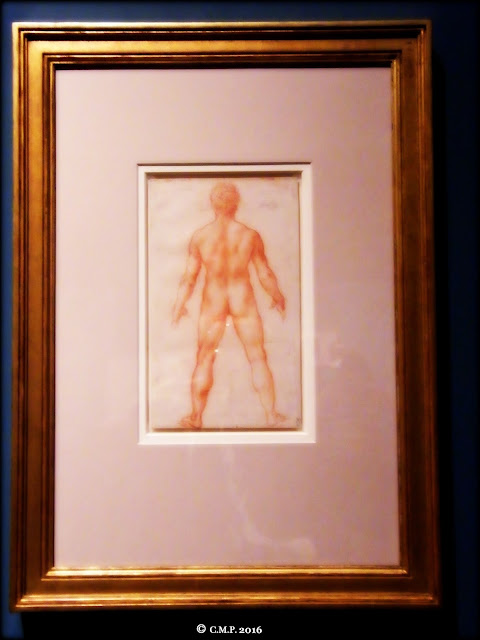During the summer of 2016 a
major artistic event took place at Nottingham Castle, proving to be a source of
great excitement for many. Today we recognise da Vinci as one of the great
artists of all time, an artistic, creative and scientific genius but this was
not always so. During his life time da Vinci was recognised as an artist of
great talent, a sculptor, a draughtsman, a surveyor, an engineer responsible
for designing wartime defences and a respected scholar. Most of these
remarkable talents and achievements have been forgotten by the general public,
today most only think of him as the man who painted the Mona Lisa or as one of
the Ninja Turtles. He was so much more.
Nottingham Castle Museum and
Art Gallery was the temporary home of this tour of ten sketches from the Royal
Collection, the personal collection of her Majesty the Queen of the United
Kingdom. These are items seldom seen by the general public and rarely so outside
of Windsor Castle. They are part of a series of tours organised by the Royal
Collection Trust, whose aims include the bringing of such items from the
collection to a wider audience than ever before.
After his death, the papers
of da Vinci became the property of his companion Francesco Melzi and were
eventually collected into volumes for preservation and display by Pompeo Leoni.
Only two volumes of such papers still exist. One is the Codex Altlanticus,
currently in the Biblioteca Ambrosiana of Milan. The second Leoni binding
eventually joined the Royal Collection sometime after the ‘English’ Civil War.
In the ninetieth century the
papers were removed from the binding, which has itself been carefully
preserved, to protect them from abrasion when the pages were turned and placed
on individual display. At the beginning of the twentieth century some were
stamped with the cipher of King Edward VII, a surprising act of vandalism
although the stamp is miniscule.
Since the 1970’s the da Vinci
sketches have been subject of a major conservation programme, that included the
mounting of some pages between ultraviolet filtered acrylic sheets, this not
only protects them from light but enables the viewer to see drawings on both
sides of the paper.
The exhibition at the Castle
was an intimate display divided between boards giving historical context and
the sketches themselves. The sketches mounted in a variety of ways, displayed
not only the artist’s remarkable ability to observe the world but also
exhibited his methodology in practise, before final completion of a work. This
as an amateur writer and photographer, I found remarkable and interesting. I do
not generally allow people to see my rough workings and poor photography, often
destroying such. I find the idea of sharing my rough works after my death
rather disturbing but I am not a da Vinci, so it is very unlikely anyone will
want to see them.
Perusing the displays one
could quickly appreciate that this exhibition was a very special one. It was a
glimpse into the mind of a creative genius, the archetypal Renaissance man.
Capturing his draughtsmanship and illustrating his enquiring mind at work.
One of da Vinci’s famous
painting is ‘the Madonna and child with Saint Anne and a Lamb.’ The finished
composition is on display at the Louvre in Paris. On display here is Nottingham
was one of the sketches made in preparation for that work and others. It was my
favourite exhibit, the exquisite beauty and human qualities of the woman are
captured to perfection.
The anatomical drawings taken
from actual dissections are naturally a major draw, capturing an early attempt
to understand the body both as art and as physiology. The drawings are
completed with such skill and accuracy, that it is relatively easy to name
organs and associated structures.
The set of engineering
drawings focused primarily upon the designs of a bronze horse that was never
completed. The ideas and plans showing the concept of casting and assembly,
illustrate the actual work behind the creation of any art. The finished project
is only the pinnacle and often does not reflect the effort required.
Linked to these sketches is
the wonderful cats, lions and dragon drawings, a study of muscle, pose and a
precise capture of perceived movement. The master artist has practised over and
over to depict the creatures, in obvious preparation for some future work.
One of the most interesting
sketches on display was surprisingly a map, made in 1504 when da Vinci was
employed as an engineer by the City of Florence. The object was to chronicle
damage to the bank after the winter thaw and consider effective defences. The
colouring is stunning and the depiction of the current captures the energy in a
remarkably subtle manner. As a comparison to the other works of a more
deliberate artistic nature, this and the anatomical drawings, truly captured
the range of da Vinci’s skill.
Throughout the exhibition
information boards helped to place the exhibits in context, with reference made
to works not included, such as the Mona Lisa obviously and the famous Venusian
Man. The exhibition was compact without being cramped and a treasure all the more
for the intimacy that suggested, so beautifully presented that each work, each exhibit
was a special delight. The exhibition was something to be savoured and something
to be remembered.
References
Clayton M. (2016) Leonardo da
Vinci: Ten drawings from the Royal Collection. The Royal Collection
Trust. London
The Royal Collection Trust































No comments:
Post a Comment